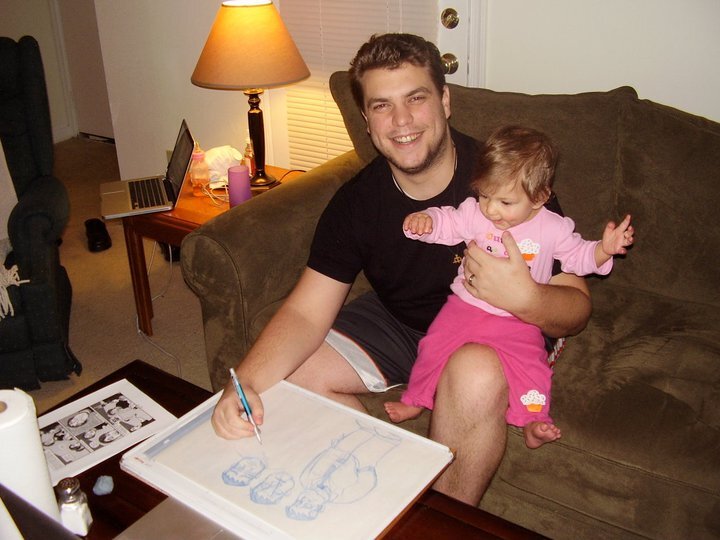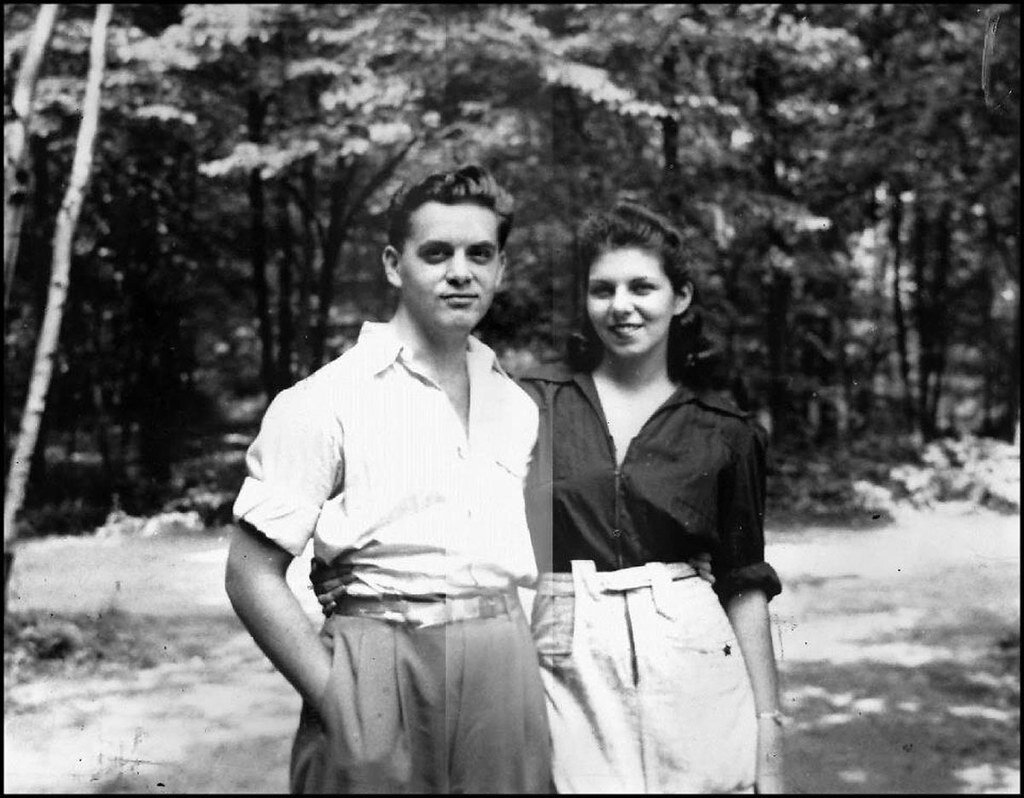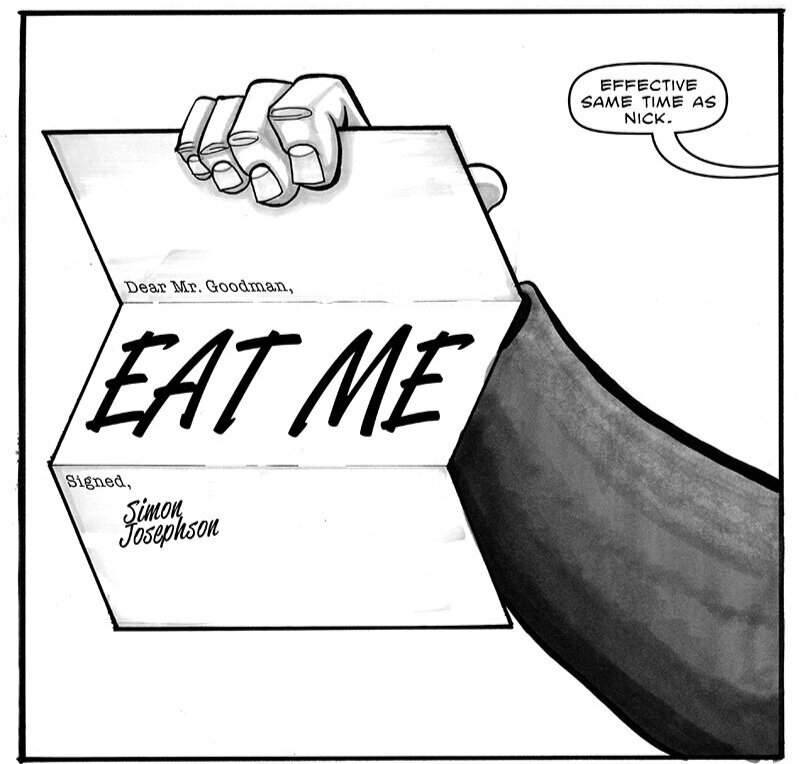Make comics long enough, study the art long enough, talk influences with your contemporaries, and you will hear the name Jack Kirby. It is inevitable.
The King himself. Rumor is he only ever had that one drafting table. Which means he drew everything on that same drafting table since his early days in the 30’s when he wast still living at home.
If this is your first time hearing about the man, allow me to bullet point all the things you really need to know:
Grew up as a small jewish kid in the Brooklyn tenements during the depression.
Never backed down from a bully. (Not even mafia goons.)
Got beat up. A lot.
Believed in comics as a high art form.
Created Captain America with his comics partner, friend, and mentor Joe Simon. Revolutionized Superhero comics. (Captain America was the first comic to sell 1 Million copies.)
Fought in Europe in WWII as an Infantryman in Patton’s army. Awarded the Bronze Star.
Married Roz at age 21. She was 19. Went on to have 4 children together. Faithful Husband. Devoted Father. (According to his wife and kids in separate interviews held after his death.)
Made Superhero comics for the company that would become Marvel Comics.
Created The Fantastic Four as a last ditch effort to save the flagging company. It worked. First Superhero Team ever made. Sold 1 Million copies again. (Named the female member “Susan Storm” after his daughter Susan.)
Went on to collaborate and create almost every Marvel superhero you’ve ever heard of (and a few DC Characters as well. (The Hulk, The X-Men, The Silver Surfer, Thor, The Avengers, Brought Captain America back, Black Panther, and there is a rumor he pitched the idea of a “Spider-Man” to Stan Lee.) (Darkseid, Orion, Caliban, and the rest of The New Gods for DC.)
Was promised more money, his original art back, royalties, and writing/creation credits of his characters by the head of the publishing company at the time, Martin Goodman. (Stan Lee’s Uncle-in-Law.)
Was screwed out of all of them for his entire career. (He did start getting his original pages back. Roz would help sell them.)
Quit comics in his 60’s to work in animation for the health insurance (The first time in his life that he would have any). Had his first heart attack that year.
Died a legend at 75 (after a 4th heart attack) with the credit and ownership of his characters still being contested in court.
Most famous quote: “Comics will break your heart, kid.”
At the time that I read his story, I was a young father burning the candle at both ends to make my comics dreams come true, and his example really inspired me. The dispute over his characters was still being litigated as well. It was a pretty open and shut case that he shared in the creation of the characters and was entitled to credit and partial, if not total, ownership. Marvel lawyers were mostly being paid to drag the case out. If Marvel lost, more than half of their Intellectual Properties would have to be turned over to Kirby’s estate, and that would be it for the nearly bankrupt publisher.
Knowing the details of the man himself, and knowing how bad he had been screwed for his entire career, well and truly broke my heart. So much so, that I imagined an elaborate bit of wish fulfillment.
That’s where Off-Panel Hero comes from.
Sometime around year 2.5 or 3 of making the same journal comic, I wanted to branch out and try some fiction with made up characters that I had to design. The Kirby Wish Fulfillment Story that I had idly kicked around was at the top of my mind. In addition to wanting to right some wrongs, I was (and am) also a sucker for the Film Noir genre of the 1940’s and 50’s. I figured, armed with my then brand new set of 12 Copic Cool Gray Markers, I could make that happen.
I did all the stuff you’re supposed to do when you write a new thing. I wrote out the script. Polished it as best I could, and then forgot about it for a few weeks. Came back, reread, filled in plot holes, and planted a Chekov gun or two. I decided I was still into the story, and set about character designing.
You can see Simon’s character design in progress right here. Drawing with a baby in my lap is not something I had to do a whole lot, but I did have to do sometimes.
Story Notes and Fun Facts
I had fun changing the names and time period to the story. Giving subtle nods here, and not-so-subtle nods there.
Jack Kirby was born “Jacob Kurtzberg,” and was later known as The King of Comics. So it was an easy thing to draw a fair facsimile of the man and call him “Jake King.”
I was heartbroken and flummoxed that Kirby had so many friends and well wishers, but that none of them could bring any pressure to bear on the Powers that Were. For that reason, I made a friend of my fictional Kirby the hero of this story. Someone who is otherwise a peon risking everything to help a friend. A Samwise to Jack’s Frodo.
Joe and Jack. Making comics and saving the world.
Jack’s real-world mentor and comics partner was Joe-Simon. The other half of Captain America. It was a no-brainer, and a fun bit of cheese, to name the hero of the story “Simon Josephson.”
Roz was about 5’ 3”. As we can see, Jack wasn't much taller.
Roz is Roz. She will always be Roz. I tried to faithfully draw her from photos taken in the mid 40’s and 50’s. I added a bit of gray to make her older and aged up Jack to make him slightly less feisty and more feeble. (The man himself was still perfectly willing to punch a man’s face well into his 60’s.)
Jack deferred his draft while he worked like a demon getting his newspaper comics backlogged so that they could run while he was over seas. Within 6 months of his return, Roz was pregnant with their first. She was nervous about what he’d say. He was overjoyed.
Martin Goodman is an actual name. That is the real guy who was in charge of a large publishing house, of which the comics wing was a small and flagging appendix. He is the one who offered and kept promising more money, more credit, royalties, etc. to Jack Kirby. It was always a handshake arrangement. Goodman was an old school businessman, cold and calculating. Handshakes mean nothing. Contracts only mean what can be enforced. He knew he had Jack over a barrel, and he kept Jack there with more promises and an empty sack.
Martin Goodman is also the one who hired Stan Lee as a favor to his wife, who was Stan’s aunt. Everyone who worked in Marvel was a journeyman/freelancer who pushed pencils for bread and had no insurance, but Stan was family. He had a salary from day one, insurance, and later was adored as the public face of Marvel Comics.
It is fair to say that he too was owed some creator’s cash from the properties he helped to foster, but he never got any. Nor did he really seek it out. He had the credit, he had the fame, and his salary was good.
Stan Lee is only mentioned once in passing. His Given name was “Stanley Martin Leiber,” so I just called him, “Stan Martin” for the character. In real life, everyone called him “Stan.” “Stan Lee,” a lengthening of his first name, is what he used as his pen name. It sounded more comic-booky and it hid his Jewish surname.
Fun Fact: The Comics Industry was almost entirely Jewish-dominated at the time, but almost all of them used a pen name, or had their name legally changed.
The opening establishing shot is taken from the Raleigh Skyline from 2011 or so. Raleigh, being a booming town, has added several buildings since then.
If I were a better story-teller at the time, I would have either skipped this establishing page entirely, or interspersed their conversation through it. Probably should have skipped it.
The posters in the back are fun easter eggs. “Famous Five” after the “Fantastic Four,” “Tor” one letter away from “Thor,” and “Romance” as a nod to the ten years Kirby and Simon spent making romance comics in the 50’s.
I have no idea what Martin Goodman looked like, but this is a fun design. That bit about printers throwing away pages when they were done. They really did. Didn't occur to them to send them back. They were on the press, and the originals were in the way. The artists complained because the pages were the only part of what they made that they owned. The printers would send them back to the office where only Stan Lee and the rest of editorial worked. The thought being artists could pick up their old originals while they were dropping new ones off. Stan didn't get the memo about the pages belonging to the artists. He used to hand them out to delivery boys instead of tips.
Exterior of Duke Hospital in Durham. My wife started nursing there shortly after this comic was made.
To my knowledge, Jack never actually punched anybody out that worked with him, but he definitely came close more than once. Will Eisner recounted how one of his employees in the early days absolutely punched out an anti-jewish employee. Jack was working for Eisner then, but it wasn't him. A tall blond goy did the punching.
Anti-Semitism in this time was a strange thing. New York was a very Jewish place to be, but was also a very WASPy place to be. The American wing of the Nazi Party (before the U.S. joined the war) held a sold out rally in Madison Square Garden while Jack and Joe were working together. The same year, they made a comic with a literal blond haired blue eyed super man punching out Adolf Hitler on the cover. That was Captain America’s first appearance.
Jack got a phone call when the comic was on the stands. The caller said: “Look here jew-boy, if you want to know what a real aryan super man can do, we’re waiting for you downstairs in the lobby.”
Jack calmly and dutifully hung up the phone, rolled up his sleeves, and walked downstairs.
No one was there.
Charlotte Skyline. The cafe depicted was a real place there in 2010. Don’t know if it’s still there. Nick Mackey is a guy wholly made up. Simon couldn't do this alone. He needed a white knight lawyer to take the case. Thus, Nick Mackey and his (uncharacteristic for New York City at the time) white suit.
His full name is “Nicholas Mackavoy.” A play on Niccolò Machiavelli. A try at a subtle nod that Nick wasn’t in it out of the goodness of his heart. He knew the winning side, and wanted to be on it.
This panel drives me bonkers! The visual tangents are marked in red. Tangents are the bane of every comic artist in the world. An incredible and severe amount of effort is spent avoiding the drawing of tangents at every level of comic making, and here I am with 2.5 tangents in one panel. UNACCEPTABLE!
Pro Tip: The quickest way to take your comics from Amateur Hour to Promising Talent is to never allow a tangent to get inked, and (most important of all) make your lettering as absolutely invisible as possible. More indie comics than not are ruined by bad lettering. Don’t let that be you.
Martin Goodman was jewish. Why is he talking smack about someone’s “Jew friend?” Again, anti-Semitism was weird at this time. Will Eisner, a devout jew and prominent saint of comics, wrote extensively about judaism at the time. There was a certain subset of Jew who thought they could get ahead by talking down about other Jews and judaism. Not sure if it worked. The way Eisner tells it, they always came off as try-hards.
A bit of wish fulfillment here. Who hasn't wanted to hand this kind of resignation to a boss?
To Wrap Up…
It’s nearly ten years later as I type this, and I still love this little short. It has everything. Love for friends, love for family, courage born of desperation, a vile villain, and a happy ending for the good guys.
In terms of writing, it holds together well and wastes no time. The whole story introduces characters, tells you who they are pretty quickly, gets them into and out of sticky situations satisfyingly over the course of one mini-comic. For the guy I was as I was making this book, it was a terrific feat to accomplish all of that.
Art-wise I was able to stretch my wings a little bit. At this time it was all journal comics so almost anyone I drew was from life and there was very little room to draw characters I made up and enjoy their own shape-language. This book only had two people drawn from life, and I was able to take liberties with them as well. I hadn’t ever tried to color as extensively with my markers than I did at this point. It was a huge experiment to see if the markers could handle it, and if I could handle them. Clumsy in places, blotchy and streaky in others, but I’m still happy with it. Nothing so bad it took from the story.
This was also the first bit of comic that I tried inking with the Pentel Pocket Brushpen. The bristles were too soft for me in the first 10 pages, but after page 20, I was able to start laying down some good lines with it. I still use that pen to this day.
I remember that I wanted very much to knock this story out in one month, but it was not to be. It took closer to 3. I remember being disappointed at my speed then (I’m even more disappointed now!) and mentioning how guys like Rob Guillory could knock out a similar page count with colors in less time. Rob himself commented on my blog the next day:
“Don’t worry about it, man. Quality takes time, and you put a lot of quality into this comic.” -Rob
Put me on cloud 9. Been riding that high ever since.
Thanks for reading.
All my best,
-Gabe D.














